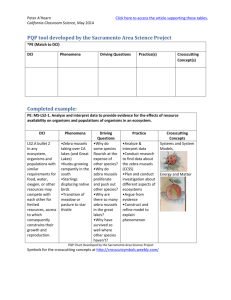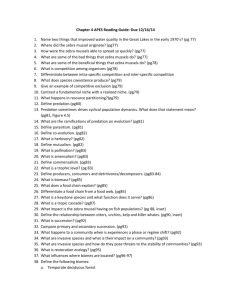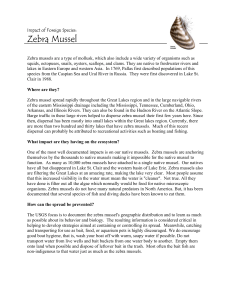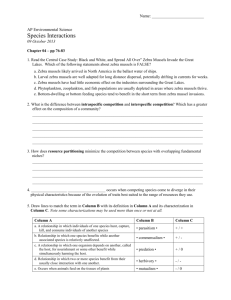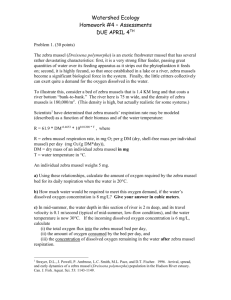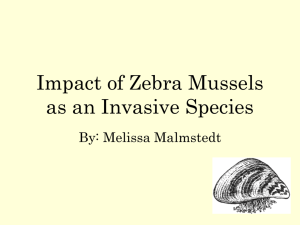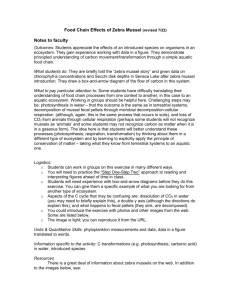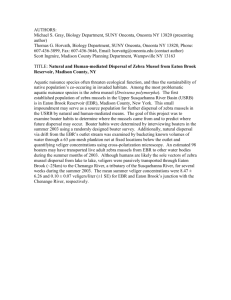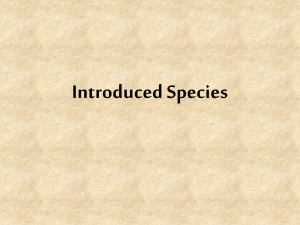Aquatic Invasions (2008) Volume 3, Issue 1: 14-20
advertisement
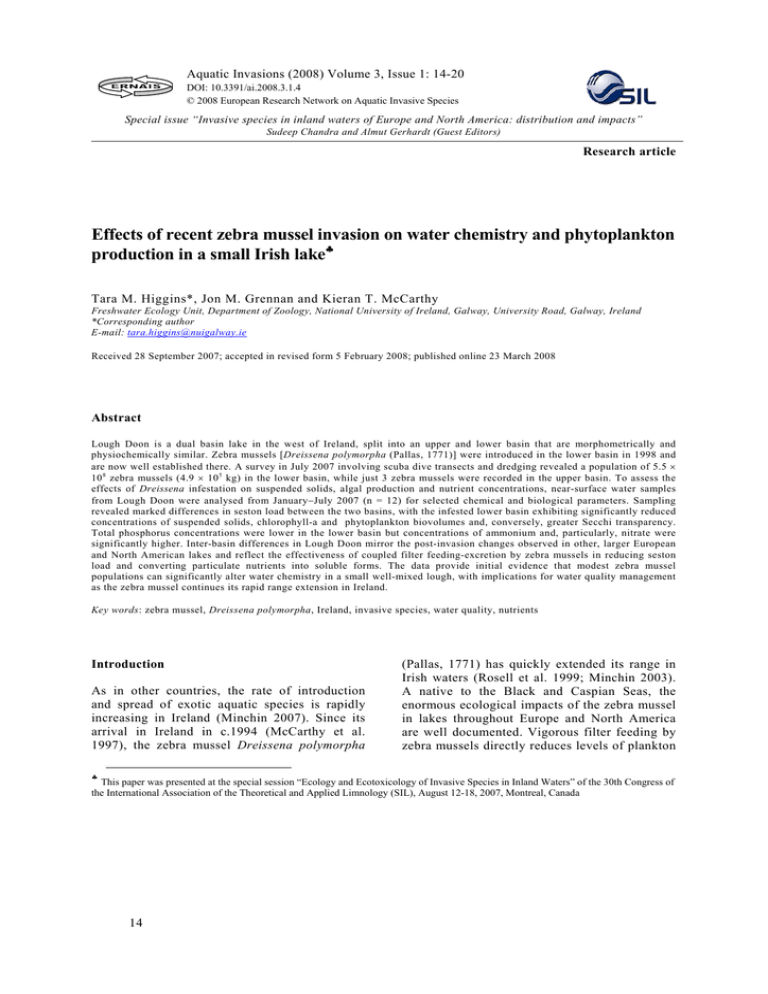
Aquatic Invasions (2008) Volume 3, Issue 1: 14-20 DOI: 10.3391/ai.2008.3.1.4 © 2008 European Research Network on Aquatic Invasive Species Special issue “Invasive species in inland waters of Europe and North America: distribution and impacts” Sudeep Chandra and Almut Gerhardt (Guest Editors) Research article Effects of recent zebra mussel invasion on water chemistry and phytoplankton production in a small Irish lake♣ Tara M. Higgins*, Jon M. Grennan and Kieran T. McCarthy Freshwater Ecology Unit, Department of Zoology, National University of Ireland, Galway, University Road, Galway, Ireland *Corresponding author E-mail: tara.higgins@nuigalway.ie Received 28 September 2007; accepted in revised form 5 February 2008; published online 23 March 2008 Abstract Lough Doon is a dual basin lake in the west of Ireland, split into an upper and lower basin that are morphometrically and physiochemically similar. Zebra mussels [Dreissena polymorpha (Pallas, 1771)] were introduced in the lower basin in 1998 and are now well established there. A survey in July 2007 involving scuba dive transects and dredging revealed a population of 5.5 × 10 8 zebra mussels (4.9 × 10 5 kg) in the lower basin, while just 3 zebra mussels were recorded in the upper basin. To assess the effects of Dreissena infestation on suspended solids, algal production and nutrient concentrations, near-surface water samples from Lough Doon were analysed from January−July 2007 (n = 12) for selected chemical and biological parameters. Sampling revealed marked differences in seston load between the two basins, with the infested lower basin exhibiting significantly reduced concentrations of suspended solids, chlorophyll-a and phytoplankton biovolumes and, conversely, greater Secchi transparency. Total phosphorus concentrations were lower in the lower basin but concentrations of ammonium and, particularly, nitrate were significantly higher. Inter-basin differences in Lough Doon mirror the post-invasion changes observed in other, larger European and North American lakes and reflect the effectiveness of coupled filter feeding-excretion by zebra mussels in reducing seston load and converting particulate nutrients into soluble forms. The data provide initial evidence that modest zebra mussel populations can significantly alter water chemistry in a small well-mixed lough, with implications for water quality management as the zebra mussel continues its rapid range extension in Ireland. Key words: zebra mussel, Dreissena polymorpha, Ireland, invasive species, water quality, nutrients Introduction As in other countries, the rate of introduction and spread of exotic aquatic species is rapidly increasing in Ireland (Minchin 2007). Since its arrival in Ireland in c.1994 (McCarthy et al. 1997), the zebra mussel Dreissena polymorpha ♣ (Pallas, 1771) has quickly extended its range in Irish waters (Rosell et al. 1999; Minchin 2003). A native to the Black and Caspian Seas, the enormous ecological impacts of the zebra mussel in lakes throughout Europe and North America are well documented. Vigorous filter feeding by zebra mussels directly reduces levels of plankton This paper was presented at the special session “Ecology and Ecotoxicology of Invasive Species in Inland Waters” of the 30th Congress of the International Association of the Theoretical and Applied Limnology (SIL), August 12-18, 2007, Montreal, Canada 14 T.M. Higgins et al., Effects of zebra mussel invasion in a small Irish lake and suspended solids in lakes, increasing water clarity (Berg et al. 1996). Nutrient cycling is altered by the excretion and filter feeding activities of zebra mussels (James et al. 1997; Arnott and Vanni 1996), while the occurrence of nuisance or noxious cyanobacteria may increase due to Dreissena-induced changes in the N:P ratio (Raikow et al. 2004). Such changes indirectly impact a wide variety of ecological processes, affecting the composition and distribution of native populations of macrophytes, macroinvertebrates, unionid mussels and fishes. Together with their nuisance biofouling of pipes and boats, these characteristics have made the zebra mussel perhaps the most notorious of aquatic invasive species. Research on zebra mussels in Ireland has to date focused on large lakes on the Shannon and the Erne river systems (Maguire et al. 2003; Pollux et al. 2003; Astanei et al. 2005; Lucy 2006; Burlakova et al. 2006; Conn et al. 2007) while North American models of zebra musselinduced changes have focused on the Great Lakes. As part of the EPA-funded BioChange project examining key threats to biodiversity in Ireland, this study (2006−2009) aims to elucidate, for the first time, the effects of recent Dreissena invasion on water chemistry and phytoplankton production in a small, well-mixed western Irish lake. Data from this study will ultimately help forecast changes in ecological processes and ecosystem structure in Irish lakes arising from zebra mussel invasion. Figure 1. An aerial view of the study lake, Lough Doon, in Co. Clare, Ireland (Google Earth™ 2007). Study Site Lough Doon is a dual basin lake situated on the middle reaches of the Owenogarney river system in Co. Clare, Ireland, in a largely agricultural catchment (Figures 1 and 2). The main inflow into the Upper basin is the Killuran River and the Upper basin discharges into the Lower basin via a channel. The outflow from the Lower basin forms the Owenogarney River, discharging into the Shannon Estuary 20 km downstream. The Upper and Lower basins are physico-chemically similar, being circumneutral, generally wellmixed systems with low residence times (Table 1), and both basins meet the optimum ranges of pH, hardness temperature and dissolved oxygen required for zebra mussel colonisation (O’Neill 1996; Rosell et al 1999). Zebra mussels have been observed in Lower Lough Doon since Figure 2. Map of the Upper and Lower basins of Lough Doon, illustrating the location of the SCUBA transects and dredges conducted during the zebra mussel population survey in July 2007. c.1998 (Minchin 2003) and the basin is now heavily colonised in the littoral zone. Zebra mussels were undetected in Upper Lough Doon until dredging in July 2007 revealed a very low population (0.05 mussels m-2). Due to its unusual split basin characteristics, Lough Doon is an ideal case study in which to monitor the effects of zebra mussel infestation on water chemistry and ecological processes in a small Irish lough. 15 T.M. Higgins et al., Effects of zebra mussel invasion in a small Irish lake Table 1. Principal morphometric and chemical characteristics of the Upper and Lower basins of Lough Doon. Values are mean for January−July 2007 (n=12) ± standard errors. Doon Doon Upper Lower Surface area (ha) 48.4 64.9 Volume (m3 ) 2.44 × 106 3.25 × 106 Mean depth (m) 5.04 5.0 Max. depth (m) 15.2 12.1 Residence time (mth) 1.88 1.67 pH 7.69 ±0.08 7.83 ±0.06 Conductivity (mS cm-1 ) 167 ±4.8 200 ±6.1 Temperature (°C) 12.4 ±1.3 13.0 ±1.3 DO (mg L-1 ) 10.5 ±0.3 10.5 ±0.3 Alkalinity (mg CaCO3 L-1 ) 72.4 ±4.4 89.7 ±4.5 Materials and Methods To estimate zebra mussel population density in the Lower basin of Lough Doon, mussels were collected by a SCUBA diver from 25 cm2 quadrats at depths of 1 m, 2 m, 3 m and 4 m along a transect. Sampling along 19 transects (n=76) was conducted in the Lower Lough Doon in July 2007 (Figure 2). To investigate the presence of zebra mussels in the Upper basin, 25−70 m long dredges were carried out using a 50 cm wide dredge (n=12). Dredge lengths were measured using a Trimble GeoXT differential GPS. Dredges were also carried out at depths of greater than 4 m in the Lower basin (n=16) where zebra mussel densities were very low and patchy (Figure 2). Zebra mussels >1 mm were counted and measured for shell length, then the entire sample was weighed for total wet weight (soft tissue plus shell) after opening mussels, removing excess water from the mantle and blotting them dry with absorbent paper. Data on mussel densities, biomass and lengths at different depths were combined with information obtained from digital bathymetric maps on the percentage areas of the basins at different depths to provide estimates of the total zebra mussel populations in the Upper and Lower basins of Lough Doon. Relationships between depth and the density, biomass and shell length of zebra mussels were tested using the Spearman correlation coefficient (r s) and significance levels determined using a two-tailed t-test. Near surface (0.2 m) samples for water chemistry analysis were collected from mid-lake stations on the Upper and Lower basins of Lough 16 Doon monthly between January and March 2007 and biweekly from April to July 2007 (n=12). Measurements of pH, dissolved oxygen (DO), conductivity, temperature and Secchi depth were made in the field with a multiparameter YSI meter and standard Secchi disk. Alkalinity was determined by standard HCl titration and total suspended solids (TSS) were determined gravimetrically (APHA 1998). Colorimetric methods were used for the determination of total phosphorus (TP) and soluble reactive phosphorus (SRP) (Murphy and Riley 1962), nitrate (Nelson, et al. 1954) and ammonium (Grashoff 1976). Chlorophyll was measured spectrophotometrically after extraction in 10% acetone/DMSO mixture (1:1v/v) (Burnison 1980). Phytoplankton cell biovolumes were calculated on Lugolspreserved samples using the equations of Rott (1981). The statistical significance of differences in water chemistry/phytoplankton biomass between the two basins was determined using the Wilcoxon Signed Ranks test. Results Results of the zebra mussel population survey (Table 2) emphasise the different levels of Dreissena infestation in the Upper and Lower basins of Lough Doon. The Lower basin had an estimated population of 5.5 × 10 8 zebra mussels (4.9 × 10 5 kg), equating to a filtration capacity of 5.22 × 10 5 m3 d -1. By comparison, the Upper basin of Lough Doon was very mildly infested. Zebra mussels were recorded in only 3 of the 12 dredges (n=5 zebra mussels) in the Upper basin, equating to a population of 2.2 × 10 4 (17 kg) and a filtration capacity of 18.1 m3 d -1. Table 2. Total number, biomass and filtration capacity of zebra mussels in the Upper and Lower basins of Lough Doon, and theoretical lake water recycling rates. Doon Doon Upper Lower Mean shell length (mm) 18.18 19.71 Total population 2.2 × 104 5.5 × 108 Total biomass (kg) 17 4.9 × 105 Filtration capacity1 (m3 d -1 ) 18.1 5.22 × 105 Recycling rate2 (d) 134,807 6 1 Filtering rate calculated as 44.4 mL g -1 WTW h -1 (wet tissue mass, shell plus tissue) 2 Theoretical recycling rate = lake volume ÷ filtration capacity T.M. Higgins et al., Effects of zebra mussel invasion in a small Irish lake The mean shell size of zebra mussels in the Lower basin was 19.71 mm (n=4,685) (Table 2) and the large majority of mussels were in the 2+ age cohort (16−23 mm) (Figure 3a). The length frequency distribution at different depths along a single transect (Figure 3b) reveals a second smaller peak at 6−9 mm, the 1+ cohort, likely representing settlement from the previous summer and autumn. The highest density of zebra mussels (1,999 ind. m-2) was recorded in the Lower basin at 1 m depth (Figure 4a), while the mean density of zebra mussels lakewide was 860 ind. m-2. Shell size, population density and biomass were all decreased significantly with depth (Figure 4a−c). At 18.18 mm, the mean shell size of zebra mussels in the Upper basin was smaller than in the Lower basin (Table 2); however, the small sample size (n=5) precludes a detailed characterisation of the zebra mussel population in the Upper basin. Figure 4. Variation in (a) density, (b) biomass, and (c) shell length, of zebra mussels with depth in Lower Lough Doon. Values plotted are mean for each depth; error bars showing the standard error (SE), Spearman Correlation Coefficients (rs) and levels of significance are also given. Data were collect by SCUBA transects (open-symbols) and dredging (closed symbols). Figure 3. (a) Length-frequency distribution of zebra mussels in Lower Lough Doon (mean shell length 19.7 ± 0.07 mm). Data are from 17 transects at depths of 1 m, 2 m, 3 m, and 4 m (n = 4,685). Also shown are length-frequency distributions along a single transect at depths of (b) 1 m, (c) 2 m, (d) 3 m and (d) 4m (n = 382) Figure 4 compares the mean water chemistry of the two basins from January to July 2007 (n=12). The Lower basin had 48% lower concentrations of total suspended solids (P=0.008), 41% lower chlorophyll concentrations (P=0.004) and 33% lower phytoplankton biomass (P=0.124), with conversely 70% higher Secchi transparency (P=0.002) (Figures 5a−d). Concentrations of TP were also lower in Lower Lough Doon but not significantly so (34%, P=0.150), while mean SRP concentrations were identical in the two basins (Figures 5e−f). Both nitrate and ammonium concentrations were significantly higher Figure 5. Comparison of water quality characteristics of the Upper and Lower basins of Lough Doon: (a) total suspended solids, (b) Secchi transparency, (c) chlorophyll, (d) phytoplankton biovolume, (e) soluble reactive phosphorus, (f) total phosphorus, (g) ammonium, (h) nitrate. Values shown are mean from January−July 2007 (n=12); error bars show standard errors. 17 T.M. Higgins et al., Effects of zebra mussel invasion in a small Irish lake in the Lower basin (134%, P=0.008 and 37%, P=0.033, respectively) (Figures 5g−h). Discussion The Upper and Lower basins of Lough Doon are physico-chemically and morphometically similar, being circumneutral and generally wellmixed systems with high flushing rates. Both basins meet the optimum ranges of pH, hardness, temperature and dissolved oxygen required for zebra mussel colonisation. At present, however, only the Lower basin contains a sizeable, well established zebra mussel population (5.5 × 10 8) while the Upper basin is only mildly infested (2.2 × 10 4) to date. The mean (860 ind. m-2) and maximum (1,999 ind. m-2) density of zebra mussels in the Lower basin of Lough Doon is relatively low compared to mean (3,900 ind. m-2) and maximum (6,800 ind. m-2) densities in Lough Key, Ireland (Lucy et al. 1995) or mean densities reported from the Great Lakes e.g. 10,000 ind. m-2 in the western basin of Lake Erie (Arnott and Vanni 1996) and 33,200 ind. m-2 in 1992 and 4,200 ind. m-2 in 1993 in Saginaw Bay, Lake Huron (Nalepa at al. 1995). Thus, the zebra mussel population in Lower Lough Doon during July 2007 can be considered a modest infestation. The movement of boats into Lough Doon via a public slipway at the Lower basin is the most likely route of initial infestation in the mid or late-1990s. Zebra mussels now heavily colonise rocks and stones, macrophytes, dead Anodonta shells and aggregations of dead Dreissena shells in the littoral zone of the Lower basin at depths of 1−3 m. Zebra mussel density, biomass and shell size all declined significantly in the Lower basin below 3 m depth. Whether this trend reflects a higher proportion of young mussels or slower growth rates at greater depths is not yet known. The large difference in zebra mussel densities in the Upper and Lower basins of Lough Doon provided a unique experimental design to investigate whether the welldocumented trends from large lakes in Europe and North America following Dreissenainfestation are replicated in a small, well-mixed Irish lough. A comparison of water chemistry data from the Upper and Lower basins from January−July 2007 provides the first indication of the impact of zebra mussel infestation on water quality in Lough Doon. The reduced concentrations of TSS, chlorophyll and phytoplankton biovolumes 18 and increased Secchi transparency in the Lower basin are likely to reflect the filter-feeding action of the zebra mussel population. Dreissena polymorpha’s efficacy in clearing large quantities of phytoplankton, small zooplankton and other suspended solids, thereby reducing water column turbidity and seston load, is well known (Berg et al. 1996, Lucy et al. 2005). Increases in the depth of the photic zone can enhance the growth of submerged macrophytes and periphyton in infested lakes (Zhu et al. 2006). Ongoing research will ascertain whether these indirect effects of zebra mussel filtration become manifest in Lower Lough Doon. As well as differences in turbidity, the two basins also differed significantly in terms of nutrient concentrations. Concentrations of TP were lower in the Lower basin, SRP concentrations showed no change while concentrations of ammonium and, in particular, nitrate were notably higher in the Lower basin. Observations of reductions in TP, a proportionately greater fraction of phosphorus as SRP and increases in nitrate and ammonium in the Lower basin of Lough Doon mirror findings from other infested lakes (Gardner et al. 1995; Holland et al 1995; Arnott and Vanni 1996; Effler et al. 1996, James et al. 2000; Conroy et al. 2005), possibly indicating accelerated recycling of nutrients by the coupled consumption-excretion activities of zebra mussel populations in the Lower basin. As zebra mussels filter large amounts of water, they also process large amounts of suspended nutrients. Ingested nutrients can be utilised for growth and reproduction, excreted in particulate organic form as faeces or pseudofaeces or excreted in dissolved inorganic forms which are readily bioavailable. Excretion rates are biomass-dependent, with larger zebra mussels having higher nutrient excretion rates (Conroy et al 2005). With a mean shell length of 19.71mm, zebra mussels in Lower Lough Doon can be categorised as large (Arnott and Vanni 1996) or moderately large (Conroy et al 2005) relative to zebra mussels in other lakes. Some studies have shown that zebra mussels excrete N:P at below the Redfield ratio of 16:1, which can decrease P limitation but increase N limitation in lakes, offering an explanation for promoted growth of cyanobacteria in infested waterbodies (Arnott and Vanni 1992). Other studies have found that nutrients are excreted at mass ratios of greater than 40, suggesting that zebra mussels are a phosphorus sink and nitrogen source (Gardner et al. 1995). There was no difference in concen- T.M. Higgins et al., Effects of zebra mussel invasion in a small Irish lake trations of SRP between the Upper and Lower basins during the current study. The likely explanation is that any remineralised phosphate would be rapidly taken up in Lough Doon due to the prevailing phosphorus-limiting conditions, as indicated by high ambient N/P ratios (TP:TN 44) in the lake. By contrast, concentrations of ammonium and especially nitrate were significantly higher in the Lower basin of Lough Doon. The direct excretion of ammonium by zebra mussels has been found to elevate ambient ammoniums concentrations in other infested lakes, profoundly affecting community nitrogen dynamics (Gardner et al. 1995). Increases in nitrate may arise indirectly from the oxidation of excreted ammonium to nitrate by nitrifying bacteria in environments where nitrogen concentrations exceed the needs of the biota (Gardner et al. 1995; James et al 1997). If, as these preliminary results suggest, excretion by zebra mussels is a major flux of dissolved inorganic nutrients, relative to other external and internal nutrient sources, it would be highly significant for the nutrient budget of Lower Lough Doon and potentially that of other similarly infested lakes. It is clear that continued monitoring and experimental manipulations are needed to conclusively demonstrate a causal link between Dreissena invasion and water quality differences between the infested and uninfested basins of Lough Doon, and to determine if these patterns persist in the long term as zebra mussel populations in the Lower basin stabilise and those in the Upper basin, likely, increase in time. Nevertheless, the coupled declines in phytoplankton biomass/turbidity and changes in nutrient concentrations recorded in the Lower basin strongly suggest that Lough Doon is experiencing similar changes following zebra mussel infestation as other larger lakes. In conclusion, our data for Lough Doon provide early evidence that modest zebra mussel populations can markedly affect water quality in small lakes, reducing turbidity, phytoplankton biomass and particulate nutrient concentrations and increasing concentrations of dissolved inorganic nutrients, particularly nitrate. This new evidence of altered nutrient dynamics and energy flows in Dreissena-infested lakes holds important implications for both the ecology of Irish loughs and water quality management practices as the zebra mussel continues to spread. Acknowledgement This research is part of the BioChange project funded by the Irish Environmental Protection Agency. References Alexander Jr. JE, Thorp JH and Fell RD (1994) Turbidity and temperature effects on oxygen consumption in the zebra mussel (Dreissena polymorpha). Canadian Journal of Fisheries & Aquatic Sciences 51:179-184 APHA (1998) Standard Methods for the Examination of Water and Wastewater, 20th ed. American Public Health Association, American Water Work Association, Water Environment Federation, Washington DC Arnott DL and Vanni MJ (1996). Nitrogen and phosphorus recycling by the zebra mussel (Dreissena polymorpha) in the western basin of Lake Erie. Canadian Journal of Fisheries and Aquatic Science 53: 646−659 Astanei J, Gosling E, Wilson J and Powell E (2005) Genetic variability and phylogeography of the invasive zebra mussel, Dreissena polymorpha (Pallas). Molecular Ecology 14: 1655−1666 Berg DJ, Fisher SW and Landrum PF (1996) Clearance and processing of algal particles by zebra mussels (Dreissena polymorpha). Journal of Great Lakes Research 22: 779−788 Burlakova LE, Padilla DK, Karatayev AY and Minchin D (2006) Endosymbionts of Dreissena polymorpha in Ireland: Evidence for the introduction of adult mussels. Journal of Molluscan Studies 72: 207−210 Burnison B K (1980) Modified dimethyl sulfoxide (DMSO) extraction for chlorophyll analysis of phytoplankton. Canadian Journal of Fisheries and Aquatic Science 37: 729−733 Conn DB, Simpson SE, Minchin D & Lucy FE (2008) Occurrence of Conchophthirus acuminatus (Protista: Ciliophora) in Dreissena polymorpha (Mollusca: Bivalvia) along the River Shannon, Ireland. Biological Invasions 10: 149−156. Conroy JD, Edwards WJ, Pontius RA, Kane DD, Zhang H, Shea JF, Richey JN and Culver DA (2005) Soluble nitrogen and phosphorus excretion of exotic freshwater mussels (Dreissena spp.): potential impacts for nutrient remineralisation in western Lake Erie. Freshwater Biology 50: 1146−1162 Gardner WS, Cavaletto JF, Johengen TH, Johnson JR, Heath RT and Cotner JB (1995) Effects of the zebra mussel, Dreissena polymorpha, on community nitrogen dynamics in Saginaw Bay, Lake Huron. Journal of Great Lakes Research 21: 529–544 Grashoff K (1976) Determination of dissolved oxygen and nutrients. In: Grashoff K, Ehrhardt M and Kremling K (eds) Methods of Seawater Analysis.Verlag Chemie, Weinheim, Denmark Effler SW, Brooks CM, Whitehead KA, Wagner BA, Doerr SM, Perkins MG, Siegfried CA, Walrath L and Canale RP (1996) Impact of zebra mussel invasion on river water quality. Water Environment Research 68: 205−214 19 T.M. Higgins et al., Effects of zebra mussel invasion in a small Irish lake Holland RE, Johengen TH and Beeton AM (1995) Trends in nutrient concentrations in Hatchery Bay, western Lake Erie, before and after Dreissena polymorpha. Canadian Journal of Fisheries and Aquatic Sciences 52: 1202– 1209 James WF, Barko JW, Davis M, Eakin HL, Rogala JT and Miller AC (2000) Filtration and excretion by zebra mussels: implications for water quality impacts in Lake Pepin, Upper Mississippi River. Journal of Freshwater Ecology 15: 429−437 James WF, Barko JW and Eakin HL (1997) Nutrient regeneration by the zebra mussel (Dreissena polymorpha). Journal of Freshwater Ecology 12: 209−216 Lucy F, Sullivan M and Minchin D (2005) Nutrient levels and the zebra mussel population in Lough Key. ERTDI Report Series No. 34. EPA, Wexford, Ireland. Available at: http://www.epa.ie/downloads/pubs/research/water/epa_z ebra_mussels_ertdi34_final.pdf Lucy F (2006) Early life stages of Dreissena polymorpha (zebra mussel): the importance of long-term datasets in invasion ecology. Aquatic Invasions 1: 171−182 Maguire CM, Roberts D and Rosell RS (2003) The ecological impacts of a zebra mussel invasion in a large Irish lake, Lough Erne: a typical European experience? Aquatic Invaders 14: 10−18 McCarthy TK, Fitzgerald J and O'Connor W (1997) The occurrence of the zebra mussel Dreissena polymorpha (Pallas 1771), an introduced biofouling freshwater bivalve in Ireland. Irish Naturalists Journal 25: 413−416 Minchin D (2003) The zebra mussel Dreissena polymorpha (Pallas) extends its range westwards in Ireland. Bulletin of the Irish Biogeographical Society 27: 176−181 20 Minchin D (2007) A checklist of alien and cryptogenic aquatic species in Ireland. Aquatic Invasions 2: 341−366 Murphy J and Riley JP (1962) A modified single solution method for the determination of phosphate in natural waters. Analytica Chimica Acta 27: 31−36 Nalepa TF, Wojcik JA, Fanslow DL and Lang GA (1995) Initial colonization of the zebra mussel (Dreissena polymorpha) in Saginaw Bay, Lake Huron: population recruitment, density, and size structure. Journal of Great Lakes Research 21: 417−434 Nelson JL, Kurtz LT and Bray RH (1954) Rapid determination of nitrates and nitrites. Analytical Chemistry 26: 1081−1082 Pollux B, Minchin D, Van der Velde G, Van Alen T, MoonVan Der Staay SY and Hackstein J (2003) Zebra mussels (Dreissena polymorpha) in Ireland, AFLP-fingerprinting and boat traffic both indicate an origin from Britain. Freshwater Biology 48: 1127−1139 Raikow DF, Sarnelle O, Wilson AE and Hamilton SK (2004) Dominance of the noxious cyanobacterium Microcystis aeruginosa in low-nutrient lakes is associated with exotic zebra mussels. Limnology and Oceanography 49: 482−487 Rosell R, Maguire CM and McCarthy TK (1999) First reported settlement of zebra mussels Dreissena polymorpha in the Erne system, Co Fermanagh, Northern Ireland. Biology and Environment: Proceedings of the Royal Irish Academy 98B: 191−193 Rott E (1981) Some results from phytoplankton counting intercalibrations. Schweizerische Zeitschrift für Hydrologie 43: 43−62 Zhu B, Fitzgerald DG, Mayer C M, Rudstam LG and Mills EL (2006) Alteration of ecosystem function by zebra mussels in Oneida Lake: Impacts on submerged macrophytes. Ecosystems 9: 1017−1028 .
